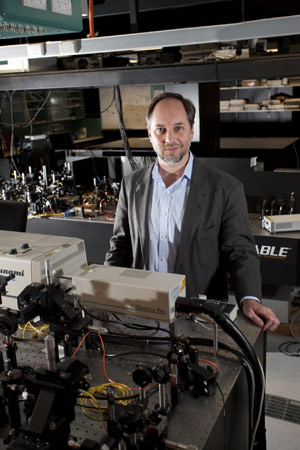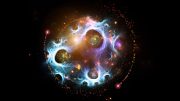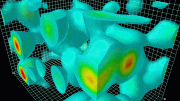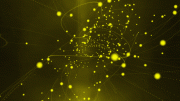
This is Professor Howard Wiseman, Director of Griffith University’s Center for Quantum Dynamics. Credit: Griffith University
In a newly published study, physicists propose that parallel universes really exist and that they interact and influence one another by a subtle force of repulsion.
Griffith University academics are challenging the foundations of quantum science with a radical new theory based on the existence of, and interactions between, parallel universes.
In a paper published in the prestigious journal Physical Review X, Professor Howard Wiseman and Dr. Michael Hall from Griffith’s Center for Quantum Dynamics, and Dr. Dirk-Andre Deckert from the University of California, take interacting parallel worlds out of the realm of science fiction and into that of hard science.
The team proposes that parallel universes really exist, and that they interact. That is, rather than evolving independently, nearby worlds influence one another by a subtle force of repulsion. They show that such an interaction could explain everything that is bizarre about quantum mechanics.
Quantum theory is needed to explain how the universe works at the microscopic scale, and is believed to apply to all matter. But it is notoriously difficult to fathom, exhibiting weird phenomena which seem to violate the laws of cause and effect.
As the eminent American theoretical physicist Richard Feynman once noted: “I think I can safely say that nobody understands quantum mechanics.”
However, the “Many-Interacting Worlds” approach developed at Griffith University provides a new and daring perspective on this baffling field.
“The idea of parallel universes in quantum mechanics has been around since 1957,” says Professor Wiseman.
“In the well-known “Many-Worlds Interpretation”, each universe branches into a bunch of new universes every time a quantum measurement is made. All possibilities are therefore realized – in some universes the dinosaur-killing asteroid missed Earth. In others, Australia was colonized by the Portuguese.
“But critics question the reality of these other universes, since they do not influence our universe at all. On this score, our “Many Interacting Worlds” approach is completely different, as its name implies.”
Professor Wiseman and his colleagues propose that:
- The universe we experience is just one of a gigantic number of worlds. Some are almost identical to ours while most are very different;
- All of these worlds are equally real, exist continuously through time, and possess precisely defined properties;
- All quantum phenomena arise from a universal force of repulsion between ‘nearby’ (i.e. similar) worlds which tends to make them more dissimilar.
Dr. Hall says the “Many-Interacting Worlds” theory may even create the extraordinary possibility of testing for the existence of other worlds.
“The beauty of our approach is that if there is just one world our theory reduces to Newtonian mechanics, while if there is a gigantic number of worlds it reproduces quantum mechanics,” he says.
“In between it predicts something new that is neither Newton’s theory nor quantum theory.
“We also believe that, in providing a new mental picture of quantum effects, it will be useful in planning experiments to test and exploit quantum phenomena.”
The ability to approximate quantum evolution using a finite number of worlds could have significant ramifications in molecular dynamics, which is important for understanding chemical reactions and the action of drugs.
Professor Bill Poirier, Distinguished Professor of Chemistry at Texas Tech University, has observed: “These are great ideas, not only conceptually, but also with regard to the new numerical breakthroughs they are almost certain to engender.”
Reference: “Quantum Phenomena Modeled by Interactions between Many Classical Worlds” by Michael J. W. Hall, D.-A. Deckert and Howard M. Wiseman, 23 October 2014, Physical Review X.
DOI: 10.1103/PhysRevX.4.041013
arXiv: 1402.6144








Perhaps a parallel universe explains Einstein’s ‘Spooky action at a distance.”.
This article is nothing more than a theoretical mix of the multiverse (multi-universe) theory and a topic becoming trendy again: quantum physics.
Even more: The multiverse theory is not scientific: By definition, we are only able to observe “our” universe. Universe = all we are able to observe. So, no “other” universe – than the current universe – can be detected, nor observed, nor investigated.
However, science needs to be observable by definition. It is mentioned in any Code of Conduct regarding to scientific research. The multiverse theory can’t be observed (and its existence can’t therefore be proven). So, as a consequence, the multiverse theory is not scientific.
Haven’t particles appeared momentarily – which shouldn’t happen scientifically – as observed by scientists? Surely this would legitimise this theory?
I do not agree with the idea that interaction between parallel worlds comes from a “force of repulsion”… I think a “world” in this context refers to its gravitational field. I consider the interaction between the intersecting gravitational fields of two nearby worlds comes from their periodical variation. On my view, gravitational fields – like universes – expand and contract periodically.
Relationships of parallel worlds with sleep and travel to different dimensions through sleep. Quantum energy in sleep. If we sleep, how fast will we travel to other worlds? Where do we get the door?
The formation of parallel paths through conversion to energy is possible. If a person moves at the speed of light, it becomes energy (Big Einstein’s theory). In fact, if we can not move at the speed of light, we can travel to the unknown world by sleeping.
… one can use the sets in order to explain it from theoretical point of view…